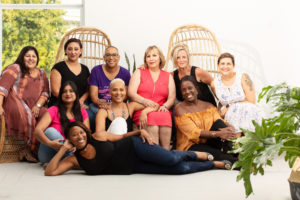Blog by Ray Anne Evans, Executive Director of Breast Cancer Resource Center
Breast Cancer Awareness Month (BCAM) is an interesting time. Pink ribbons and the color pink are everywhere!
Many survivors call it Pinktober (and it’s not meant to be a fun term). It’s a time that breast cancer is in your face and for too
many women, it reminds them of many negative things: the death of a loved one to breast cancer, the betrayal of their own body
by a disease that can kill them, the loss of the breasts they used to feed their babies. For young women, it’s a reminder that they
can no longer bear children or feel comfortable in their own skin. Let us not forget that it still claims the lives of 40,000 women
every year.
I choose to look at BCAM a bit differently. October reminds me that it is time to get my annual mammogram. It also encourages
me to pause, take a breath and be grateful for my life today. After being diagnosed with breast cancer in 1997, I have been able to
watch my children grow up. I can spend time with my two grandchildren who bring me indescribable joy. I am able to work with
the many incredible women at the Breast Cancer Resource Center and inspirational donors and volunteers like Felicia Reed. I
reflect on the lives of the friends I have lost to this disease, and I remember them and their loved ones. And I continue to hope
that one day breast cancer can be cured and BCRC can cease to exist.

Over the last several years, there has been so much confusion around breast health. It’s imperative that you are aware of what is
normal for your breasts. By doing breast self-exams regularly you will know how your breasts vary in sensitivity and texture
during different times in your menstrual cycle. Know what is normal for you and when to consult your doctor. It’s also important
to understand common screening and diagnostic tests for breast health such as clinical breast exams, mammograms, and breast
ultrasounds.
Another thing that is perplexing is knowing at what age you should start getting mammograms. Susan G. Komen, American
Cancer Society and the U. S. Preventive Services Task Force all have different recommendations when it comes to screening for
breast cancer. Ultimately, I believe the decision on when to get your first and subsequent mammogram is up to you and your
doctors. You should decide together. When discussing with your physicians, let them know any concerns you have associated with
the screening process (like exposure to radiation) or worries about a false positive or a false negative. Both can happen and cause
extreme anxiety. Also, be sure to let them know if a family member (mother, sister, aunt, grandmother) had breast cancer and
know (if possible) their age at diagnosis and whether they survived it. As a person with no family history of breast cancer, I
believe that mammography is the best tool we have for finding the disease early while it can be identified, treated, and hopefully
cured.

And while October can be difficult for survivors, you can choose to use it as a reminder for getting your mammogram, honoring
those that we have lost by talking to others about they joy they brought to your life or donate to your favorite nonprofit. The BCRC
would be so grateful for you gift! Also, remember us if you or someone you know is diagnosed with breast cancer. We are here to
guide, support and educate. Breast Cancer Resource Center is here for you. Help. Hope. Here.

